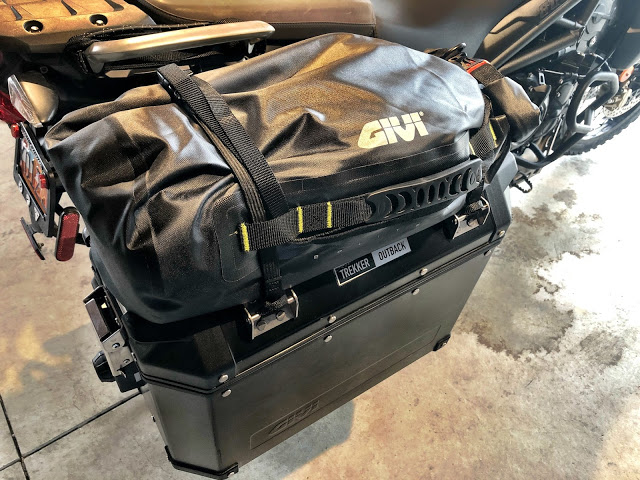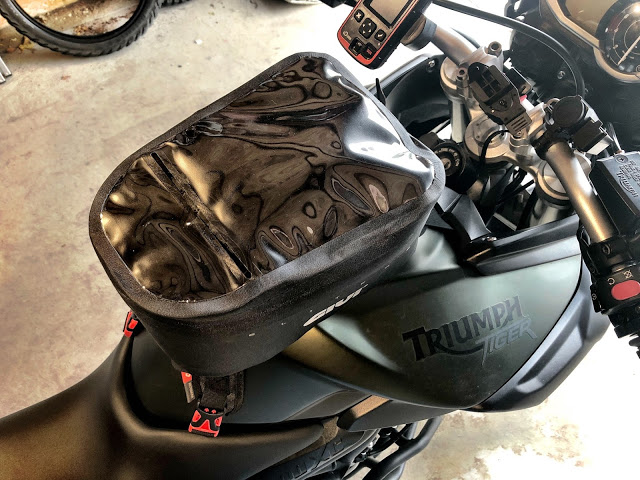Taking it all with you worked well in my dad’s Buick station wagon, but not so much on a dual sport motorcycle. There’s a hierarchy at work here, much like Maslow’s physical stuff – water, shelter, clothing, and food. I’ll add WiFi as well. And since Maslow wasn’t a rider, he didn’t list tools and fluids, so I’ll add that to the list.
In packing for the road there are a couple of other considerations in getting all that stuff to go – utility and size, not to mention the Tiger XC’s payload of 492 lb. (225k). I weigh in with my riding gear at 245 pounds, leaving me 247 pounds to work with, keeping in mind that I’ll ride two-up on occasion.
The trick to packing for any adventure is finding things that provide multiple uses. Adding to that challenge, I like to source stuff from existing unused stuff. It’s a bonus when both these criteria can be reached.
 Let’s start with things mechanical. In addition to a tire repair kit (modified for tube tires), I carry a tool roll customized during a tear-down of the Tiger to audit what should be included. Not seen here are tire irons and a spare front tube.
Let’s start with things mechanical. In addition to a tire repair kit (modified for tube tires), I carry a tool roll customized during a tear-down of the Tiger to audit what should be included. Not seen here are tire irons and a spare front tube.
 The tool roll is borrowed from a Coleman camp utensil kit that is bound by a hook/loop adjustable strap I cannibalized from a post-surgical arm brace.
The tool roll is borrowed from a Coleman camp utensil kit that is bound by a hook/loop adjustable strap I cannibalized from a post-surgical arm brace.
So, besides the strap’s binding around the tool roll, it’s also a front parking brake for the bike when I need it stabilized.
 From the top of Maslow’s list, when I’m off road away from natural water sources I pack water in an MSR dromedary bag that attaches to the top of the left pannier. When there’s naturally sourced water, I use an MSR water filter and fill the bag at camp.
From the top of Maslow’s list, when I’m off road away from natural water sources I pack water in an MSR dromedary bag that attaches to the top of the left pannier. When there’s naturally sourced water, I use an MSR water filter and fill the bag at camp.
 As for shelter, all camp gear packs into the right pannier in two layers. The bottom layer seen below stows the ExPed sleeping pad, the Teton ComfortLite pillow and the REI Helio sleeping bag. The Helio is a warm-climate down bag that packs small and can be converted to something warmer using the Thermolite liner. There’s a Sea-to-Summit Tek towel in there somewhere as well.
As for shelter, all camp gear packs into the right pannier in two layers. The bottom layer seen below stows the ExPed sleeping pad, the Teton ComfortLite pillow and the REI Helio sleeping bag. The Helio is a warm-climate down bag that packs small and can be converted to something warmer using the Thermolite liner. There’s a Sea-to-Summit Tek towel in there somewhere as well.

The top layer has the Lynx2 tent, the REI Flex Lite chair, the Sea-to-Summit Thermolite bag liner and the ground cover tarp. Everything is stowed in order of deployment, tarp, tent, chair, sleeping kit. Anal, I know, but it makes set-up and take down more efficient. Each item was selected based on packability and optimum utility.

In the pannier’s lid is a Camillus Camtrax 3-in-1 hatchet retained by shock cord that’s webbed around tabs build into the pannier lid.

The left side pannier is home to gear that’s needed while traveling. Attached to the lid is a first aid and trauma kit, a dual band (HAM) radio, and a pouch that contains a tourniquet. Tucked in on top of the kit is a can of chain lube.

The pannier holds dehydrated Mountain House food packs, cooking gear including a JetBoil, a GSI Halulite Minimalist cook set with gas and a compact Brunton stove, and an insulated mug that also contains a small coffee container. Above that layer of gear I pack my HotWired gear, seasonal gloves, rain gear – anything I need to grab roadside as temps and elements change over the 5000 feet of altitude changes on my commute.

The Givi Tail Bag holds clothing, three-days worth, along with electronics and toiletries. I carry a small laptop that links through my iPhone’s hotspot giving me WiFi wherever I have a cell signal. I use an inReach GPS for satellite connection.

Lashed to the right pannier is a Givi Cargo Bag that contains my camera bag and tripod.
The tank bag holds items that need to be quickly accessed, along with an LED headlamp, flashlight, Leatherman, Lightning charging cable for the iPhone and other cables to charge the Sena and inReach. Warm weather gloves, RainX, sunglasses and other necessities round out the contents.

All told, there’s about 73 pounds, a little over 33 kilos striking a balance back there. Honestly, there’s very little difference in road manners when the Tiger is loaded. Off-road is a different story, but not a dramatic one.
We learned to pack this way when we were touring on ocean kayaks and found much of the gear to translate well to moto camping. We also adventure in an overland rig that gives us a bit more space, but we still pack to conserve every square foot.
